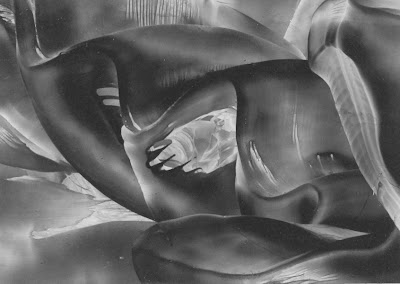 |
| color swatches arranged partially by value |
So, what is value? The best definition I've come up with is that value describes the quality(ies) of lightness or darkness in a particular object or composition. When design folk talk about value, they use terms like "high" and "low" instead of light and dark.
High Value refers to very light values shading to white.
Low Value refers to very dark values shading to black.
Medium Values refer to (you guessed it) greys somewhere in the middle of the scale between light and dark.
To talk about how the different values in a composition work together we use the term Contrast.
If a piece is made up of a number of widely differing values it has High Contrast. So, a piece made up of black and white, like a chessboard, has high contrast. The greater the value differences, the greater the contrast, the more the individual values will stand out in a black & white photo.
If the values in a piece are all relatively close, then a piece is considered to have Low Contrast. In Low Contrast compositions all of the values cluster in one section of the value scale - high, medium or low. Pastels are a great example of a high value, low contrast composition.
Discarding color information makes it easier to look at value compositions. Take a look at the two photo collages below and you'll see what I mean.
.jpg) |
| from top left: Winter Flame, Ocean Currents, Sea Life, Spanish Dancer |
All of my compositions tend to hover in the mid-values, which is fairly common amongst modern bead and fiber artists oddly enough. My Ocean Currents bracelet stretches the farthest into the high and low values, ranging from a deep cobalt blue to bright white. My Sea Life pendant's not far behind. But interestingly enough, my Winter Flame pendant shows far less value contrast along the outer edges than I might have expected. I'll talk about the reason for that in next week's post.
Why do we care about value?
1) Value contrast can help us to differentiate between the various elements in a composition.
2) Value can help direct your eye through a composition, as our eyes are drawn to lighter, brighter objects first.
3) Value carries an emotional impact. Take a look at the three abstract paintings below (from an original encaustic wax painting by Carol Trammel) - what is your initial, emotional response to each piece? I've used an abstract to help remove contextual input.
 |
| high value, low contrast |
 |
| mid value, mid constrast |
 |
| low value, low contrast |
All three are the same composition, but I adjusted their value levels. What adjectives would you use to describe your reaction to each?
Now it's time to take a look at your own compositions. Does your work tend to cluster around one segment of the value scale? Which end? Does your work tend to have high or low contrast?
.jpg)
What a great concept of posts this is. I've always wanted to take an art class to get a deeper understanding of things like value, hue, tint...your explanation is wonderfully clear and just may save me some class tuition fees!
ReplyDeletevery nicely demonstrated. Thank you
ReplyDeleteI've been enjoying your "instructional" posts, Karen. You've explained these concepts so even a colour wannabe like me can benefit!
ReplyDeleteThis is SO interesting, Karen. I have struggled to understand these terms before, but your examples are really helpful. After reading your post, I put all my works in progress on my scanner and printed them out in black and white. Turns out everything I'm working on is mid-value and low contrast. I'll be watching for next week's post!
ReplyDeleteWhat an awesome lesson on value! I love how you altered the photo of your work to illustrate the concept. :)
ReplyDeleteMy value tends to be low-to-medium. This has changed just slightly since I discovered a love for hints of black and white.